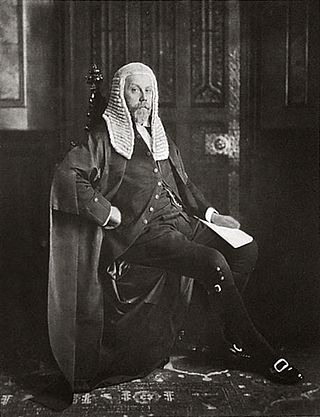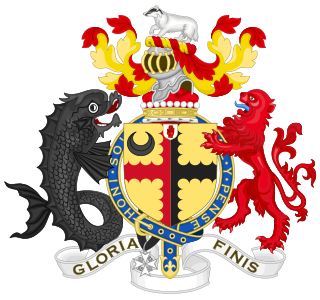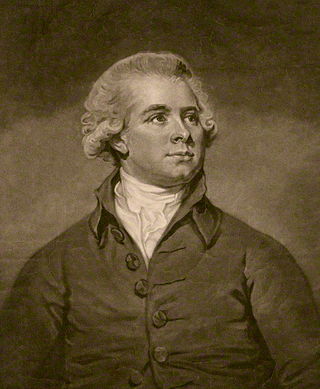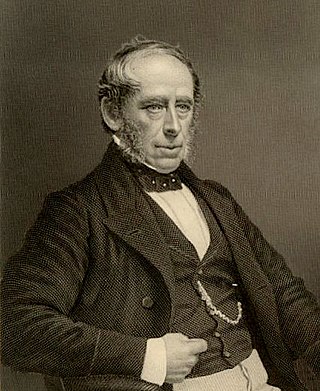The Earl of Courtown, in the County of Wexford, is a title in the Peerage of Ireland. It was created on 12 April 1762 for James Stopford, 1st Baron Courtown. He had previously represented County Wexford and Fethard in the Irish House of Commons. Stopford had already been created Baron Courtown, of Courtown in the County of Wexford, on 19 September 1758, and was made Viscount Stopford at the same time he was given the earldom. These titles are also in the Peerage of Ireland. He was succeeded by his eldest son, the second Earl. He was a Tory politician and served under William Pitt the Younger as Treasurer of the Household from 1784 to 1793. On 7 June 1796, he was created Baron Saltersford, of Saltersford in the County Palatine of Chester, in the Peerage of Great Britain. This title gave him and his descendants an automatic seat in the House of Lords.

Viscount Ullswater, of Campsea Ashe in the County of Suffolk, is a title in the Peerage of the United Kingdom. It was created in 1921 for James Lowther upon his retirement as Speaker of the House of Commons. He was the eldest son of the Hon. William Lowther, third son of the Hon. Henry Lowther, second son of William Lowther, 1st Earl of Lonsdale. The first Viscount lived to the age of 93, and was pre-deceased by both his eldest son the Hon. Christopher Lowther, a Conservative politician, and his eldest son's eldest son John Arthur Lowther (1910–1942), the title being inherited by his seven-year-old great-grandson, the second and current Viscount, in an extremely rare instance of a great-grandson succeeding his great-grandfather in a peerage. The second Viscount held office in the Conservative administrations of Margaret Thatcher and John Major and since 2003 he has been one of the ninety elected hereditary peers that remain in the House of Lords after the passing of the House of Lords Act 1999.

Viscount Brookeborough, of Colebrooke in the County of Fermanagh, is a title in the Peerage of the United Kingdom. It was created in 1952 for the Ulster Unionist politician and Prime Minister of Northern Ireland, Captain The Rt. Hon. Sir Basil Brooke, 5th Bt., P.C. (N.I.), M.P.

Baron Henniker, of Stratford-upon-Slaney in the County of Wicklow, is a title in the Peerage of Ireland. It was created in 1800 for Sir John Henniker, 2nd Baronet, who had previously represented Sudbury and Dover in the House of Commons. His son, the second Baron, also sat as a Member of Parliament. In 1792 he assumed by Royal licence the additional surname of Major. He was childless and was succeeded by his nephew, the third Baron. He assumed the additional surname of Major by Royal licence in 1822. His son, the fourth Baron, represented Suffolk East in Parliament. In 1866 he was created Baron Hartismere, of Hartismere in the County of Suffolk, in the Peerage of the United Kingdom. This title gave him and his descendants an automatic seat in the House of Lords. He was succeeded by his son, the fifth Baron. He also sat as Member of Parliament for Suffolk East and later held minor office in the Conservative administrations of Benjamin Disraeli and Lord Salisbury. His grandson, the eighth Baron, was a prominent diplomat and notably served as British Ambassador to Jordan and to Denmark. As of 2014 the titles are held by the latter's son, the ninth Baron, who succeeded in 2004.

Baron Ellenborough, of Ellenborough in the County of Cumberland, is a title in the Peerage of the United Kingdom. It was created on 19 April 1802 for the lawyer, judge and politician Sir Edward Law, Lord Chief Justice of the King's Bench from 1802 to 1818. His son, the second Baron, notably served as Governor-General of India. On 22 October 1844 the second Baron was created Viscount Southam, of Southam in the County of Gloucester, and Earl of Ellenborough, in the County of Cumberland. These titles were also in the Peerage of the United Kingdom. His only son predeceased him and on his death in 1871 the viscountcy and earldom became extinct.

Baron Hampton, of Hampton Lovett and of Westwood in the County of Worcester, is a title in the Peerage of the United Kingdom. It was created in 1874 for the Conservative politician Sir John Pakington, 1st Baronet.

Baron Glanusk, of Glanusk Park in the County of Brecknock, is a title in the Peerage of the United Kingdom. It was created in 1899 for Sir Joseph Bailey, 2nd Baronet, who had earlier represented Herefordshire and Hereford in the House of Commons as a Conservative. Both his son, the second Baron, and grandson, the third Baron, served as Lord Lieutenant of Brecknockshire. The latter was succeeded by his first cousin, the fourth Baron. He was the son of the Hon. Herbert Crawshay Bailey, fourth son of the first Baron. As of 2010 the titles are held by his son, the fifth Baron, who succeeded in 1997.

Baron Grenfell, of Kilvey in the County of Glamorgan, is a title in the Peerage of the United Kingdom. It was created on 15 July 1902 for the military commander Sir Francis Grenfell. His eldest son, the second Baron, was Deputy Speaker of the House of Lords and Chairman of Committees from 1963 to 1976. As of 2010 the title is held by the latter's son, the third Baron, who succeeded in 1976. He previously worked for the World Bank. Lord Grenfell lost his seat in the House of Lords after the passing of the House of Lords Act 1999. However, in 2000 he was made a life peer as Baron Grenfell of Kilvey, of Kilvey in the County of Swansea, and was able to return to the House of Lords.

Baron Glentoran, of Ballyalloly in the County of Down, is a title in the Peerage of the United Kingdom. It was created on 8 July 1939 for the Unionist politician Herbert Dixon. In 1950 he also succeeded his elder brother as third Baronet, of Ballymenock. His son, the second Baron, was also a politician and served as the last Speaker of the Senate of Northern Ireland. As of 2017 the titles are held by the latter's son, the third Baron, who succeeded in 1995. He is a former Olympic bobsleigh gold medallist as well as a soldier, businessman and politician. Lord Glentoran was one of the ninety elected hereditary peers who remain in the House of Lords after the passing of the House of Lords Act 1999, and sat on the Conservative benches until his June 2018 retirement under the House of Lords Reform Act 2014.
Baron de Mauley, of Canford in the County of Dorset, is a title in the Peerage of the United Kingdom. It was created on 10 July 1838 for the Whig politician the Hon. William Ponsonby, who had earlier represented Poole, Knaresborough and Dorset in the House of Commons. He was the third son of the 3rd Earl of Bessborough, an Anglo-Irish peer, and the husband of Lady Barbara Ashley-Cooper, one of the co-heirs to the ancient barony by writ of Mauley, which superseded the feudal barony the caput of which was at Mulgrave Castle, Yorkshire, which barony by writ had become extinct in 1415. His son, later the second Baron, sat as Member of Parliament for Poole and Dungarvon.
Baron Palmer, of Reading in the County of Berkshire, is a title in the Peerage of the United Kingdom. It was created in 1933 for the businessman and patron of music, Sir Ernest Palmer, 1st Baronet. He had already been created a baronet, of Grosvenor Crescent in the City of Westminster, in the Baronetage of the United Kingdom on 26 January 1916. The Palmer family had made its fortune from their ownership of the firm of Huntley & Palmers, biscuit manufacturers, of Reading. As of 2017 the titles are held by the first Baron's great-grandson, the fourth Baron, who succeeded his uncle in 1990. He is the son of the Hon. Sir Gordon Palmer, Lord Lieutenant of Berkshire from 1978 to 1989, younger son of the second Baron. Lord Palmer is one of the ninety elected hereditary peers that remain in the House of Lords after the passing of the House of Lords Act 1999, and sits as a cross-bencher.
Baron Mancroft, of Mancroft in the City of Norwich, is a title in the Peerage of the United Kingdom. It was created in 1937 for the Conservative politician Sir Arthur Samuel, 1st Baronet. He had already been created a Baronet, of Mancroft in the City of Norwich in the County of Norfolk, in 1932. His son, the second Baron, was also a Conservative politician. In 1925 he assumed by deed poll the surname of Mancroft. As of 2010 the titles are held by the latter's only son, the third Baron, who succeeded in 1987. He is one of the ninety elected hereditary peers that remain in the House of Lords after the passing of the House of Lords Act of 1999. Lord Mancroft sits on the Conservative benches.
Baron Revelstoke, of Membland in the County of Devon, is a title in the Peerage of the United Kingdom. It was created on 30 June 1885 for the businessman Edward Baring, head of the family firm of Barings Bank and a member of the Baring family. Baring was the son of Henry Baring, third son of Sir Francis Baring, 1st Baronet, and the nephew of Alexander Baring, 1st Baron Ashburton, the second cousin of Francis Baring, 1st Baron Northbrook, the elder brother of Evelyn Baring, 1st Earl of Cromer and the uncle of Evelyn Baring, 1st Baron Howick of Glendale. He was succeeded by his second but eldest surviving son John, the second Baron. John was a partner in Baring Brothers and Co. Ltd, a Director of the Bank of England, and also served as Lord Lieutenant of Middlesex. On his death the title passed to his younger brother Cecil, the third Baron. He acquired Lambay Island, north of Dublin, in 1904. As of 2017 the title is held by his great-grandson, the seventh Baron, who succeeded his father in 2012.

Baron Rea, of Eskdale in the County of Cumberland, is a title in the Peerage of the United Kingdom. It was created in 1937 for the businessman and Liberal politician Sir Walter Rea, 1st Baronet, who had earlier represented Scarborough, Bradford North and Dewsbury in the House of Commons. He had already been created a Baronet, of Eskdale in the County of Cumberland, in 1935. He was succeeded by his eldest son, the second Baron. During the Second World War he served as personal staff officer to Brigadier Colin Gubbins, the Head of SOE, a key British intelligence and guerrilla operations agency. Lord Rea served as Leader of the Liberal Party in the House of Lords from 1955 to 1967. His daughter, the Right Hon. Ann Felicity Rea, married SOE veteran Malcolm Munthe in 1945. His nephew, the third Baron, who succeeded in 1981, was a physician. He was one of the ninety elected hereditary peers elected to remain in the House of Lords after the passing of the House of Lords Act 1999, and sat on the Labour benches. As of 2020 the titles are held by his son, the fourth Baron, who succeeded his father in that year.
Baron Rotherwick, of Tylney in the County of Southampton, is a title in the Peerage of the United Kingdom.
Baron Rathcavan, of The Braid in the County of Antrim, is a title in the Peerage of the United Kingdom. It was created on 11 February 1953 for the Unionist politician Sir Hugh O'Neill, 1st Baronet. He had already been created a Baronet, of Cleggan in the County of Antrim, on 17 June 1929. O'Neill was the third son of Edward O'Neill, 2nd Baron O'Neill and the uncle of the Prime Minister of Northern Ireland Terence O'Neill, Baron O'Neill of the Maine. Lord Rathcavan was also a male-line descendant of Edward Chichester, 1st Viscount Chichester. He was succeeded by his eldest surviving son, the second Baron. He succeeded his father as Unionist Member of Parliament for Antrim in 1952, a seat he held until 1959, and was later a member of the Parliament of Northern Ireland. As of 2014 the titles are held by his son, the third Baron, who succeeded in 1994.

There have been two baronetcies created for persons with the surname Arthur, both in the Baronetage of the United Kingdom. As of 2014 both creations are extant.
Colonel Fulke Southwell Greville-Nugent, 1st Baron Greville, known as Fulke Greville until 1866, was an Irish Liberal politician.

Matthew Arthur, 1st Baron Glenarthur,, known as Sir Matthew Arthur, 1st Baronet, from 1903 to 1918, was a Scottish businessman.

Sir Thomas Glen Glen-Coats, 1st Baronet, was a Scottish businessman and Liberal Party politician.












